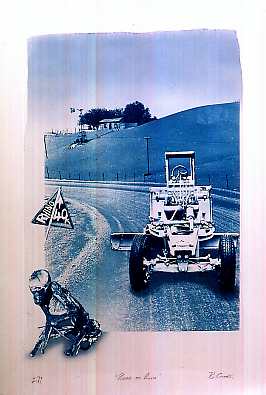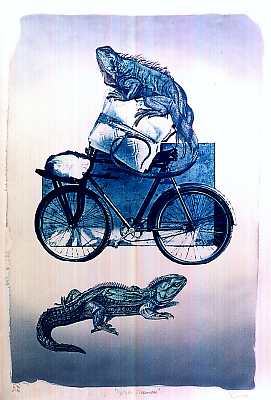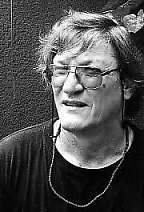Bob Cnoops


Artists
- Wim Botha
Bob Cnoops

- Hugo Crosthwaite
- James de Villiers
- Sasha Fabris
- Gordon Froud
- Rookeya Gardee
- David Hlynsky (Canada)
- Ashley Johnson
- Nkosinathi Khanyile
- Ania Krajewski
- Michael Matthews
- Nhlanhla Mbatha
- Rankadi Mosako
- Margi Scharff (USA)
- Diane Victor
DASART shows
Transmigrations - the show
Fokofo
Dasart Archives
Working Title : Ritual Imagery
I choose to use composite imagery utilizing the Cynotype process to convey my reactions to and my interpretations of the complexities of the social and political life in South Africa. As the social experience as a whole is determined collectively by a number of smaller aspects, so do the Cynotypes combine several separate images to collectively form a more comprehensive social and visual statement. These separate images are essentially of a metaphoric and symbolic nature. The use of handmade paper and the blue Cynotype process is a purely aesthetic choice which combines well with the subject material. It also has the added practical advantage of very superior archival properties.
My long-held fascination with Bushmen and their art, general graffiti and primitive wall art, has had a strong influence on my personal work. It is this influence which has led me to make statements and observations in my photographs about life and circumstances around me. Particularly striking to me is how often modern life situations strongly resemble situations depicted in ancient rock paintings: the customs, rituals and everyday social strata.
In the early '90s I attended a weeklong course on African Divination techniques and demonstrations by the well known Sanussi (a Sangoma of the highest order) and seer/healer, Credo Mutwa. The course consisted mainly of three interrelated aspects: contacting and communicating with the ancestors, divination through the mediumship of the ancestors or through the mediumship of sacred objects, and long term regional and global predictions.
In my personal work since then I have repeatedly used symbols and metaphors in African tribal customs, and especially the spiritual belief systems, to express the meanings of the composite images. What particularly interests me is the very fine and fluctuating line drawn between madness and extreme eccentricity. Madness usually results in total rejection by the community, with extreme consequences, while the most bizarre eccentric will be treated with utmost respect and even fear. Two well known examples of this treatment are Credo Mutwa himself and the artist, Jackson Hlungwane. Mutwa is both revered and reviled in the same community. The two camps are generally divided by age: the young who revile him and the old who revere him. Hlungwane, on the other hand, is revered as an artist by the young (not the old), and revered as a "prophet" and seer by the older section of the community.
Another version of this type of high regard is the case of epilepsy sufferers. These people are usually treated with utmost respect due to the belief that there is very close communication with the spirit world during an epileptic fit. It would appear that this is because of the resemblance to the deep trance state, common amongst the Bushmen. Interestingly, it has been noted that epileptics are often more spiritually receptive or 'psychic', than non-sufferers.
Bob Cnoops
Top